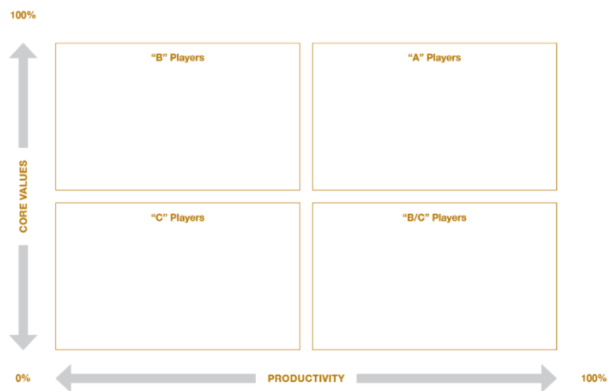How good is your team? This is a simple question that often involves facing up to hard truths. If your plans for 2020 include scaling up your business, you need to prioritise talent assessment. Nothing is more crucial to your future success than having a talented team you can rely on, which is why integrating talent assessments into your strategy is essential. These assessments are pivotal in evaluating an individual’s skills, knowledge, and potential, ensuring you have the right people in place to achieve your goals.
When working with clients, I find it takes them roughly 50 days to fill a role. That’s a long time. Factor this into your plans. If you take action now, you should be able to bring new talent in by the end of the first quarter of 2020. If you’re too slow, you’ll find they won’t make any material difference this year.
MYTH 1: A-Players cost more. FALSE
Right from the start, I take clients through my talent assessment process. It’s one of the first things we look at in our two-day kick-off. A simple grid that sorts staff into A-Players, B-Players, C-Players and Toxic-As (on the chart as B/C). Remember, the definition of an A-Player is the top 5 to 10% of available talent for a given job, salary and location. This acts as their line in the sand. All subsequent assessments can be bench-marked against this.
What is an A Player?
A Play·er
/ ā plā-ər/
Noun
Also spelt “A-Player”
- An employee who is in the top 10 per cent of their profession on an industry-wide basis for the salary paid.
- A person on your team whom you would enthusiastically rehire.
- The employees at an enterprise who drive all the profitability and growth.
- A person of high integrity who delivers on commitments.
- The employee every organisation covets.
— synonyms: awesome employee, top performer, high performer, rock star, all-star, superstar, team player, game-changer
(From the A Player by Rick Crossland)
This might mean making some tough decisions. To ensure individuals meet the A-player criteria, it’s crucial to use talent assessment tools to evaluate candidates’ skills, personality traits, and potential accurately. Start by looking at your leadership team. Remember, it casts a long shadow.
Important context for this process is Gallup’s recent research into performance. They ranked people into A, B, C and D categories. When they got to discussing the results with the people involved, all the A-Players knew they were better than everyone else in their company. But not that they were better than those outside the business – good news for retention!. But C and D Players thought they were above average because, 9 times out of 10, there was no transparency of expected behaviours or performance in their company. They simply didn’t know. What do we learn from this? These frameworks need to be part of your plan.
Start with the executive team in the hiring process
As always, these things start at the top. I don’t believe a business can be better than its leadership team. If you’re a business leader, this has to be the first place you look at talent. Hiring managers are crucial in evaluating the executive team and making strategic hiring decisions that align with the company’s goals and values.
Ask yourself two questions for every member of the executive team. ‘If they resigned tomorrow, would I be disappointed?’ and ‘Knowing what I know about them now, would I rehire them in 2020?’ There needs to be a resounding ‘yes’ to both of these. Any ‘no’ answers mean that person will hold you back again in 2020. Even if you just pause, it’s a ‘no’, because it wasn’t an obvious ‘yes’. You need to take action straight away. Refining the hiring process is crucial for ensuring the executive team is composed of A-players, driving the company towards success.
Every member of your top team needs to be an A-Player. If they’re not, this should be your target from the outset. It took one of my CEO clients nearly two years until he felt confident that he had the right people on the bus and in the right seats on his executive team. Some mistakes, some mis-hires, and not wanting to change everyone at once meant it took twice the length of time of our original estimate.
An A-Player will live and breathe your company’s purpose and core values. If you asked the rest of your staff who are the golden lights or star players who represent the DNA of your company, they should immediately point towards the directors.
And what about you? Can you honestly say, hand on heart, that you live the values of your company? If not, it’s likely that you haven’t got the right core values. In the past, I’ve worked in an organisation that had ‘excellence’ as a core value. It couldn’t have been further from the truth. If it had been ‘frugality’, that would have been much more authentic and useful. But there was very little excellence…
Assess your managers

Above – My Talent Assessment Grid: A, B or C Players?
So you believe you have the right leadership team. What next? It’s time to look at anyone who manages people. Remember that 85% of an employee’s experience of their employer is driven by their interaction with their team leader or manager. This really matters for engagement and job performance.
To begin with, get your executive team to rank their managers on the same grid of A, B and C Players (see above). You need a behavioural framework based on your core values to do this effectively. It’s often easy to spot the people who don’t fit or are culturally adrift from the rest of the company. You’re trying to spot the 25 to 35% of staff that need values-based action. Considering managers’ personality traits is crucial in ensuring they align with the company’s core values and contribute positively to the team’s dynamics and overall performance.
The decision on ranking a manager is best done collectively. You’ll often find when someone works directly with the person concerned, they’re less aware that they don’t fit. Usually, their peers will point this out based on feedback from their team and their own impressions. The closer you get to someone, the harder it is to be objective and call it out.
Once your behavioural framework is in place, every manager needs to understand how it works and the expectations implicit in it. So, in any performance-related discussion, they should know instantly whether they are living this particular value and give evidence of them doing it—complete clarity.
Here are some thoughts from Steve Jobs on the subject of talent and how his understanding of its impact came late to him.
I observed something fairly early on at Apple, which I didn’t know how to explain then, but I’ve thought a lot about it since. Most things in life have a dynamic range in which [the ratio of] “average” to “best” is at most 2:1. For example, if you go to New York City and get an average taxi cab driver, versus the best taxi cab driver, you’ll probably get to your destination with the best taxi driver 30% faster. And an automobile; what’s the difference between the average car and the best? Maybe 20%? The best CD player versus the average CD player? Maybe 20%? So 2:1 is a big dynamic range for most things in life. Now, in software, and it used to be the case in hardware, the difference between the average software developer and the best is 50:1; maybe even 100:1. Very few things in life are like this, but what I was lucky enough to spend my life doing, which is software, is like this. So I’ve built a lot of my success on finding these truly gifted people, and not settling for “B” and “C” players, but really going for the “A” players. And I found something… I found that when you get enough “A” players together, when you go through the incredible work to find these “A” players, they really like working with each other. Because most have never had the chance to do that before. And they don’t work with “B” and “C” players, so it’s self-policing. They only want to hire “A” players. So you build these pockets of “A” players and it just propagates.
The Importance of Working With “A” Players
Assess talent throughout your business using talent assessment tools

Finally, you need to apply your talent assessment grid to the rest of your team, utilizing talent assessment tools to streamline the process across the company. As well as a clearly understood behavioural framework, you must set a couple of KPIs (Key Performance Indicators) for each role (I’ll discuss more about this and define job roles next week). This will enable every employee to rate themselves objectively each day, week, and month through skills assessments, which are crucial in evaluating employees’ competencies and aligning them with the company’s performance standards. And you’ll start to facilitate the transition from top-down management to managers as coaches.
Again, start with team members who are exceptional from a performance perspective. Put names on Post-it notes, and they go into the A-Player box. Action to take from this: a slap on the back. They should be told that they’re valued, high-performing members of the team and thanked for their contribution.
Then, look at the C-Players. Who are the under-performers? Who do they work for? There are four possible actions for C-Players, depending on the individual. Terminating them should be a last resort. Maybe you think they’re a values-fit but are underperforming due to a lack of clarity about their KPIs (very common). Are they in the right role, or is the team dynamic wrong? Perhaps they’d thrive better elsewhere in the company? Is their role too broad? Give them less to do and clarity on expectations. These are all things you can solve.
Decide on the action you’ll take and who will own it. Get back together in the next quarter to review it. If their performance still doesn’t improve, they need to go.
And if they’re still not a values-fit, it’s non-negotiable. They definitely need to go.
This was in my mind over Christmas when I read several articles about Secret Santa and how much some staff hated it. They whinged on about their colleagues, accusing them of giving something inappropriately because they didn’t know them. That attitude annoys me. They have a choice. It’s obvious they hate where they work, so why don’t they just get a CV together and bugger off somewhere else! Don’t work in a job you don’t like. And get people who don’t value their jobs, company, or team off your bus! Negativity kills. It is four times more powerful than positivity. Treat negative employees as toxic.
MYTH 2: Every firm needs its core of plodders to protect against staff turnover. RUBBISH
Then we get to the B-Players. This is often the trickiest part, and I can see the terror in clients’ faces when they realise the action they need to take. Why are they scared? Because they’re not having these types of performance-based or values-based conversations every week. It’s imperative that your company gets to a place where staff are volunteering this stuff for themselves. They should know whether they’ve had a good week against their KPIs in their weekly check-ins. This should be really clear and tracked every day. Managers don’t want to initiate these conversations because they fear the question, ‘What do I need to do to be an A-Player?’ A good KPI framework will take away their fear!
Set targets within your talent assessment framework

Work out the percentage of your company that are currently A-players and use this as a baseline for future progress, incorporating a talent assessment framework to evaluate individuals’ KPIs and align with business objectives. When I start this, it can be anything between 10% and 35%, depending on how well the business has been run and how much the wheat has been sorted from the chaff. Often, it is on the lower end in firms growing via M&A.
Your aim should be to get this target up to 90%. Having dealt with the C-Players, you also need to ensure any B-Players only get to stay on the bus if they have the potential to be an A. Implementing a talent assessment program can support continuous talent development and retention, identifying high-potential employees and developing a pipeline of talented leaders. As you progress towards this, you’ll see a big uptick in recruitment and retention – A-Players like to work with fellow A-Players, so you’ll attract and keep the best people.
Sometimes, this process involves some really hard decisions. Take what I call the ‘Toxic A-Players’. These are people who have particular skills and expertise that are valuable but aren’t a good cultural fit. In my experience, they’re often salespeople or network engineers. They may be delivering well against their performance targets and the business perceives that it would be hard to replace them. So, they get away with their destructive behaviour.
Sometimes, an intervention can work. One of my clients had been having particular problems with a staff member for over six months. They ended up giving him an ultimatum. Using their core values, they narrowed in on one toxic behaviour. If it didn’t cease, he was out. The guy concerned seems to have taken it on board and changed. Time will tell. One thing’s for sure: you have to be brutal about this. Just one bad apple can spoil the bunch.
Measure job performance progress
Start at the leadership level, move on to managers and look at functional areas and teams. Slice and dice the data however you want.
The first time you do this, it will be top-down. Ultimately, you need to get to a place where the information comes bottom-up. It needs to be rolled out to your organisation in such a way that every employee is clear on their individual KPIs. They should be able to measure these themselves daily, weekly, monthly and quarterly. Their A, B or C Player ranking will come from a performance and cultural perspective. And the path towards becoming an A-Player should be crystal clear. They will know what excellence looks like.
Make sure you’re not directly measuring people against each other. Each staff member should be treated as an individual with their own individual targets. KPIs should differ for each person, based on their expertise, length of service and what they’ve achieved in the past. This will avoid setting employees against each other. It’s not a competition, this isn’t forced ranking.
Put in a measure for engagement. The process of regular talent assessment should drive this up. My personal favourite is FridayPulse but there are others. To make your core values and purpose live in your company, make sure you catch people doing the right thing and encourage all staff to give praise and thanks through a values lens.
Finally, you can use a system such as Metronome Growth Software to monitor and track all the data needed for your talent assessment. I offer this as part of my service to clients, and they find it a really easy tool for tracking KPIs, strategy, priorities and metrics.
Great companies are built by great people – fact. If your people are letting you down, you must get a grip. Establish a system for regular talent assessment based on measurable performance and cultural indicators. Roll this out and make sure it’s clearly communicated with every one of your staff. And introduce a daily, weekly, monthly and quarterly cadence which includes performance discussions. That’s how to hit your target of 90% A-Players in your organisation.
I wouldn’t think like this or have seen the power of this system in action without the amazing work of Brad Smart and his book Topgrading . Listen to our conversation on Mind Your F**king Business.
Regular talent assessments are crucial for effective talent management, ensuring the continuous alignment of talent with organizational goals and addressing the challenges of identifying and developing potential leaders for future roles. here.
Written by business coach and leadership coaching expert Dominic Monkhouse. Contact him to schedule a call here. You can order your free copy of his book, Mind Your F**king Business here.

